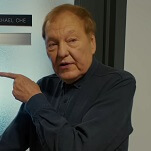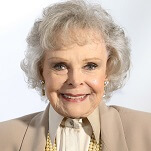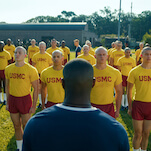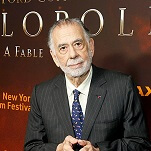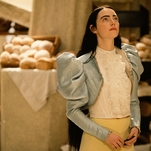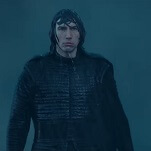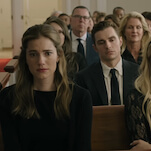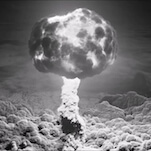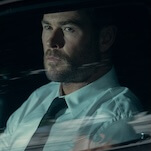I suspect co-creators David Lynch and Mark Frost would agree with young me on the last point at least. Twin Peaks is often very funny, even in this episode, which contains some of the series’ most horrific moments. It is always, always daring you to have about five or six multiple emotional reactions at once, usually one being abject horror and the other being ironic laughter. That the series is able to handle these tonal shifts with aplomb—as opposed to simply settling in favor of one or another—is what sets it apart from its many imitators. So many shows that aim to be Twin Peaks end up only aping the visual style—hello, The Killing—or the messiness of its tone—that would be Bates Motel. What they miss is that Twin Peaks used these tools in service of something deeper. There’s a rich emotion to this show that is vast and mournful, but it sits in a reservoir the series itself has yet to dive into. It holds the emotion at a distance, daring the audience to dive in before it does, and it always wins the fake out.
But as with any Lynch project, there’s care taken to build toward that supremely terrifying moment before letting us feel its emotions on the way back down. Lynch understands catharsis better than many filmmakers, and he uses that to his advantage here. The episode may start out indulging some of the series’ comedic side (as in that goofy opening featuring Lynch as the character Gordon Cole), but Angelo Badalamenti’s score begins to grow more and more pervasive and ominous as the episode builds toward that climax. And then after Leland/Bob has killed Maddy, everything pulls back just a little bit, giving the whole ensemble space to grieve for something they don’t even know has happened yet. It’s masterful and still unlike anything else on TV.
Genevieve, I know you’re watching this episode for the first time. Did it work on you as it worked on me now? Or was your reaction closer to that of 9-year-old me?
Genevieve: I’m going to have to side with 9-year-old Todd on this one, at least in terms of most of this going over my head. Twin Peaks is one of my biggest TV blind spots. I watched the first two episodes in a television course in grad school, and then never went back, not because I didn’t find the show interesting, but because having to watch something is one of the best ways to ensure you won’t want to continue watching. Obviously I can’t declare this with any sort of authority, but I’d put good money on “Lonely Souls” being the absolute worst episode of Twin Peaks to jump back into the series with, because it so clearly builds on countless moments that have piled up since those first two episodes. So, a lot of what I suspect was meant to be startling, unsettling, or funny came out as confusing, such as Nadine’s (Wendy Robie) amnesiac ramblings at the diner—which I’m pretty sure is meant to be played for humor, but seem to be rooted in something bigger or more sinister—or Sarah Palmer’s (Grace Zabriskie) vision of a white horse. I know enough about Twin Peaks and David Lynch to know these things may not even make much sense in context, but out of context, most of “Lonely Souls” plays like a series of vignettes.
But even out of context and from the emotional remove I was watching with, the sequence in the Palmers’ living room is quite affecting, due in large part to the direction. Todd, you mention how the scene “unlocks the secret terrors of a fairly normal living room,” and I’d just like to highlight and underline and put a big red circle around that statement. Lynch frames and lights that room in a manner that makes it seem utterly mundane and that contrasts with the sense of the supernatural that pervades the show to create abject terror. Even before anything was really happening with Leland/Bob, I was on edge, waiting for something to pop out, or the walls to start bleeding or something. Ultimately, that sense of anticipatory terror may have softened the blow of what actually happened, since the events that take place build on a history I only know in pieces. But the feeling of what could happen made my brain vibrate.
In addition to the framing and lighting, much of that sensation boils down to the use of music and sound in this episode, which is rather incredible. I don’t know if this is typical of all Twin Peaks episodes or just those directed by Lynch, but the aural cues throughout “Lonely Souls” drive the sense of lurking terror. It’s played for laughs, but the sound of incessantly bouncing balls in the lobby of the Great Northern put me on edge, a sensation that was echoed and amplified by the sound of the clicking turntable that soundtracks Sarah Palmer’s crawl across the floor. That sense of repetitive, empty noise creates a metronome effect that’s the opposite of soothing in this setting. And the music in “Lonely Souls” is similarly perverse, presenting seemingly pleasant or innocuous songs in a context that renders them, if not quite threatening, at least unsettling. The intro to Louis Armstrong’s “What A Wonderful World” seems pleasant enough, were it not played immediately after we see the dangling feet of Harold Smith (Lenny Von Dohlen), as the camera pans over that very same living room where later tragedies occur. (The selection of that spoken intro, rather than the much more well-known and oft-used sung portion is itself just a little bit skewed.) And then the two songs sung by the band at The Roadhouse, which bookend Maddy’s murder, have a dreamy quality that makes their ’50s sweetness feel a little too cloying, as if we’re being drugged or lulled into a complacency, making the events between the songs seem even more horrifying.
Clearly, I processed “Lonely Souls” more as a series of moments and visions than as a narrative or emotional arc, which is leaving out a big part of the story, but I think the fact that it works as a series of moments is itself impressive. However, I’d like to hear from someone who was looking at the bigger picture. Zack, you mainlined all of Twin Peaks leading up to this episode; how did it play as part of the larger whole?
Zack: Well, I did my best, anyway—managed to re-watch most of season one for the second time, the season-two premiere, and the episode right before “Lonely Souls.” So, while I can’t tell you right off what that white horse meant, I can tell you the scene with Nadine does have some context: She tried to kill herself at the end of the first season, and seems to have lost most of her adult memory. The sinister aspect comes from the fact that Nadine is freakishly strong, and her husband Ed (Everett McGill) had an affair with Norma (Peggy Lipton), the pretty blonde woman who runs the diner. There’s a whole knotted-up history between the three of them, which is basically the case with nearly every romantic relationship in town. Unlike Todd and Carrie, I haven’t finished the series yet, so I can’t say for sure if Nadine ever snaps, but on Twin Peaks, the real power always comes from the endless moments leading up to catastrophe. The first season does a fine job in setting the scene, and establishing the show as a kind of off-kilter murder mystery, but the more you watch, the less relevant that mystery becomes, at least in conventional sense. As the tall man tells Agent Cooper (Kyle MacLachlan), all of this has happened before, and will again—the show exists in a state of stasis. Lovers form and re-form trysts, greedy businessmen try to manipulative the situation to their advantage, and heroic lawmen work to find justice. But underneath, it all keeps happening over and over and over.
Okay, before I get too esoteric, I’d like to talk a little about the non-Leland/Bob scenes—the parts that nobody’s really going to remember. While Twin Peaks was a heavily serialized show, much of what we see in this hour revolves around a basic theme: people lurking behind their own faces, with comical and sinister results. In addition to Nadine’s fractured attempt to recapture adolescence, there’s also Leo Johnson (Eric Da Re), the wife-abusing thug who got shot last season and is now back at home in the care of his estranged wife and her lover. Leo doesn’t do a whole lot, but we’re constantly being asked to question just how aware he is of what’s going on around him, just as Shelly (Madchen Amick) and Bobby (Dana Ashbrook) keep jumping at the smallest sign of revival. There’s a whole plot about “new shoes”, but all that really matters is that he’s an unknown quantity as much as Nadine is and a potential explosion sitting at the kitchen table, burping up goo.
The episode starts with our heroes visiting the Great Northern on the word of a one-armed shoe salesman who is currently possessed by Bob’s nemesis, Mike (Gary Hershberger). It’s a chaotic, strange scene that, as so often with Lynch, gains power by the incongruous elements: in this case, a group of Navy personnel in uniform wandering the lobby, many of them bouncing rubber balls as they go. Mike has an attack just as Benjamin Horne (Richard Beymer) strides in, which leads to another of those dualities—here, it starts with Audrey (Sherilyn Fenn) confronting her father about his secret relationship with Laura, forcing him to reveal his One-Eyed Jack’s self to a daughter who already knows the truth, and ends with Benjamin getting carted off to jail. It should be comforting. Ben fits all the criteria for Bob’s host, and Cooper, who is one of the most trustworthy law enforcement officers to ever appear onscreen, is confident. But it’s just another false face, a mistake made because it’s the more comforting option. Taking the word of “a friend of her father’s” literally is so much better than the truth.
Does it sound like I’m turning this into a word search puzzle? It feels like that, a little. I don’t know how much of what I’ve described is intentional; more, I don’t know how much it matters in terms of the episode’s actual power, which is deep and scarring. I will say that all these little riffs on lurking threats and hidden personalities feel like a long setup to the hour’s brutal, horrifying payoff. I felt tension in my chest through most of this, long before anything of real significance occurred, because I knew what was coming and because so much of what we see happen in that first half hour feels like a held breath, an expectation of terrors to come. That stasis, the way everything in Twin Peaks feels like the pause stretched out to infinity, giving sequences like Maddy’s death tremendous power. This is a show that doesn’t build to its reveals—it waits for them. The standard concept of “rising action” doesn’t really seem to apply here, because there’s a sense that the best or the worst is always just about to happen.
That makes the effect of those moments almost impossible to articulate. The framing; the banal lighting; the clicking phonograph; the way Leland first strangles, and then punches Maddy, a quick jab to the face that somehow makes the whole scene—one that in many ways is one all too familiar to anyone watching television as it’s just another dude strangling a lady—more personal, ugly, and vile. It’s that Lynchian mixture of the childishly awkward and the achingly profound. And over at the roundhouse, the one person who might have stopped this madness is getting advice from a mystical giant, advice that is in no way helpful, just as all the symbols and messages and dreams have failed to prevent more horror. The outside forces are not interested in saving anyone. There’s nothing to save. This has all happened before.
Okay, Carrie—you say you’ve seen this show already, and that you mostly only remember Bob. What about him stays with you? And how did you react to this episode now, as opposed to when you first watched it?
Carrie Raisler: Like Genevieve, I watched Twin Peaks for a class assignment (Full disclosure: Genevieve and I went to the same grad school, albeit at different times, so I have a funny feeling we took the exact same class.), and I have some recollection of watching at least a few episodes of the series when it actually aired, but I didn’t see the infamous Bob reveal until much later when the DVD set came out and I marathon-watched both seasons in a quick frenzy. My problem with remembering Twin Peaks now is that my brain is strange in that it can recall literally thousands of random, emotionally charged pop-culture moments, but doesn’t have any capacity to retain plot details, particularly from abstract narratives. This makes David Lynch’s work very difficult for me because immediately after seeing it, I forget everything I’ve just experienced, aside from a few iconic images and one or two standout moments.
I think this special memory affliction of mine is exactly why—despite watching the whole series just a few years ago—Bob is one of the few things I can remember with any amount of specificity. While logically I know the experience of watching the show is about so much more than Laura Palmer’s murder and Bob (and you can tell as much from the careful, measured structure of this episode) the emotional horror of the reveal that Leland Palmer molested and killed his daughter while possessed by some thing, some brutal thing that possesses him again while he kills Laura’s lookalike cousin, is almost shocking in how personal it feels even when watching it now without remembering any of the context of the episode beyond Bob.
As everyone has already mentioned, the way the sequence in the Palmer house is shot is key to its power. But while the scenes leading up to the attack build the terror in excruciating slowness, the attack itself is what I’ve remembered, the one thing that still pings my brain when the words “Leland Palmer” are mentioned. It alternates between the weird, stylized hysteria of Bob and the brutal, painful realism of Leland, all punctuated by sound and camera angle. Bob’s scenes are all slow motion and distorted sound, but when Leland punches Maddy, the action returns to normal speed, all sound drops out except for the droning record player, and you’re suddenly not in a dreamy horror movie so much as a creepily mundane domestic nightmare. It’s the kind of nightmare that Zack mentions we’ve seen a thousand times before on television, but is somehow creepier because of just how sadly common attacks like these are in the real world.
That’s the true horror here—that Leland Palmer is far scarier than Bob. I admit that I forgot Bob’s face completely, having fully transposed Leland’s face into all my memories of this scene, because he’s the much scarier monster: The monster that lives in your house. In the heightened reality of Twin Peaks’ world, a world full of strange idiosyncrasies, having a father abuse and kill his own child is so abjectly normal in comparison that the contrast is almost grotesque. Bob doesn’t scare me (though Frank Silva gives an intensely weird look into the mirror here that might give me a few unpleasant dreams tonight) because he’s this intangible other, something that feels like it is literally from another world. Leland is all too real.
That’s why my favorite thing about this episode upon re-watch isn’t the scary Bob sequence I remembered, it’s everything that happens in the bar leading up to that sequence. Everyone in that bar is just having such a damn normal time—as normal of a time as you can have in Twin Peaks anyway—right up until all of the ambient action drops out and Cooper gets the mysterious, horrific message that it’s all happening again and he can’t stop it. Because no one can truly stop the insidious evil that lives in private houses—evil like Leland Palmer.
Todd, is my inability to remember any of the events that surround the Bob reveal coloring my view of Leland Palmer? Is Bob the real monster here?
Todd: I don’t think so, Carrie. The interesting thing about Twin Peaks is that you can sort of have it both ways. You can pretend this is a show with an offhand Americana mythology and that Bob is a demon who possessed a normal family man and turned him into a monster. Or you can follow the show’s notions of duality to the logical conclusion and realize that all of us possess the ability to turn into that monster, to give way to the awful impulses we keep at bay, because we know the consequences of letting them out. The reason Wise is so perfect for this role is because you all at once understand how he could be terrified by a demon that possessed him and how he could use that as a convenient excuse to do the monstrous things he does. Or, to use a much more mundane demon familiar to all of us, getting drunk makes it easier to be an asshole, but the person who makes the choice to push others away is always you, no matter how much you’ve had.
I can’t help but think of this episode in terms of Lynch’s belief in the use of transcendental meditation. Not only are the images cooked up for this episode the sorts of things that one can only come up with in the throes of really letting the mind wander, but there’s also a deep, abiding sense of the circularity of life. On any other show, Laura Palmer having a lookalike cousin who comes to town and suffers the same fate as her would feel like pointless story padding. Here, it feels like just a part of the way the universe works. We are trapped in the same cycles of desire and frustration, because we want things we cannot and sometimes should not have. The only way toward enlightenment is to free oneself from desire, but that’s the trick, isn’t it? There’s always something else to want. Leland Palmer finds himself trapped in this endless cycle, and it unleashes a great evil inside of him, an evil that has always existed and is older than him, sure, but also one he taps into all too easily. And it’s that which continues to haunt Twin Peaks, long after the show chronicling the town went off the air.
Next time: One of our other groups looks at Garfield’s Halloween Adventure, the other readers’ choice pick for “scary episodes” month.
And after that: For November and December, we’ll be looking at episodes centered on “celebrations.” Get your nominations ready!

